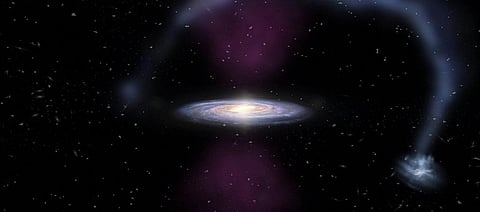

A supermassive black hole in the centre of the Milky Way galaxy exploded 3.5 million years ago, according to a study.
The black hole, known as Sagittarius A, or Sgr A* (pronounced Sagittarius A-star) — about 4.2 million times more massive than the Sun — exploded due to nuclear activity, according to a team of scientists at Australia's ARC Centre of Excellence for All Sky Astrophysics in 3 Dimensions (ASTRO 3-D).
The burst, known as a Seyfert flare, created two huge ‘ionisation cones’ of radiation, which flared to both poles of the galaxy and out into deep space.
The impact was felt at Magellanic Stream — a long trail of gas extending from nearby dwarf galaxies called the Large and Small Magellanic Clouds — which lies at an average 200,000 light years from the Milky Way, said the Australian-US research team.
“The flare must have been a bit like a lighthouse beam,” said Joss Bland-Hawthorn, professor at ASTRO 3-D.
“Imagine darkness, and then someone switches on a lighthouse beacon for a brief period of time,” Bland-Hawthorn added.
The blast took place just 3.5 million years ago — 63 million years after an asteroid wiped out the dinosaurs.
Moreover, during the time of the explosion, our earliest ancestors — the Australopithecines — were roaming in Africa, revealed the study, to be published in The Astrophysical Journal.
While Milky Way was always thought “as an inactive galaxy, with a not so bright centre”, the new study “instead opens the possibility of a complete reinterpretation of its evolution and nature”, said co-author Magda Guglielmo from the University of Sydney.
“A massive blast of energy and radiation came right out of the galactic centre and into the surrounding material. This shows that the centre of the Milky Way is a much more dynamic place than we had previously thought. It is lucky we're not residing there!” said Lisa Kewley, director of ASTRO 3-D.
The study follows a 2013 research, also led by Bland-Hawthorn, which ruled out a nuclear starburst as the cause of the massive explosive event. It had linked the event to activity in SgrA*.
Although the new study, which used data gathered by the Hubble Space Telescope, asserts SgrA* as the prime suspect more research needs to be done on how black holes evolve, influence and interact with galaxies, the researchers noted.